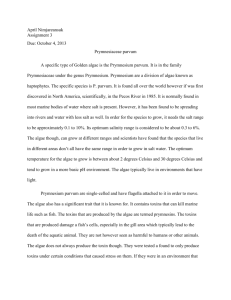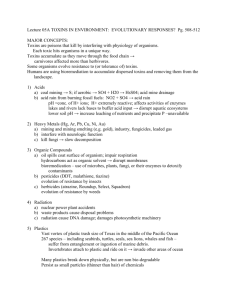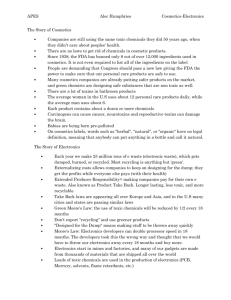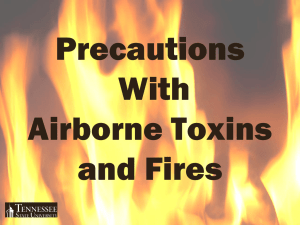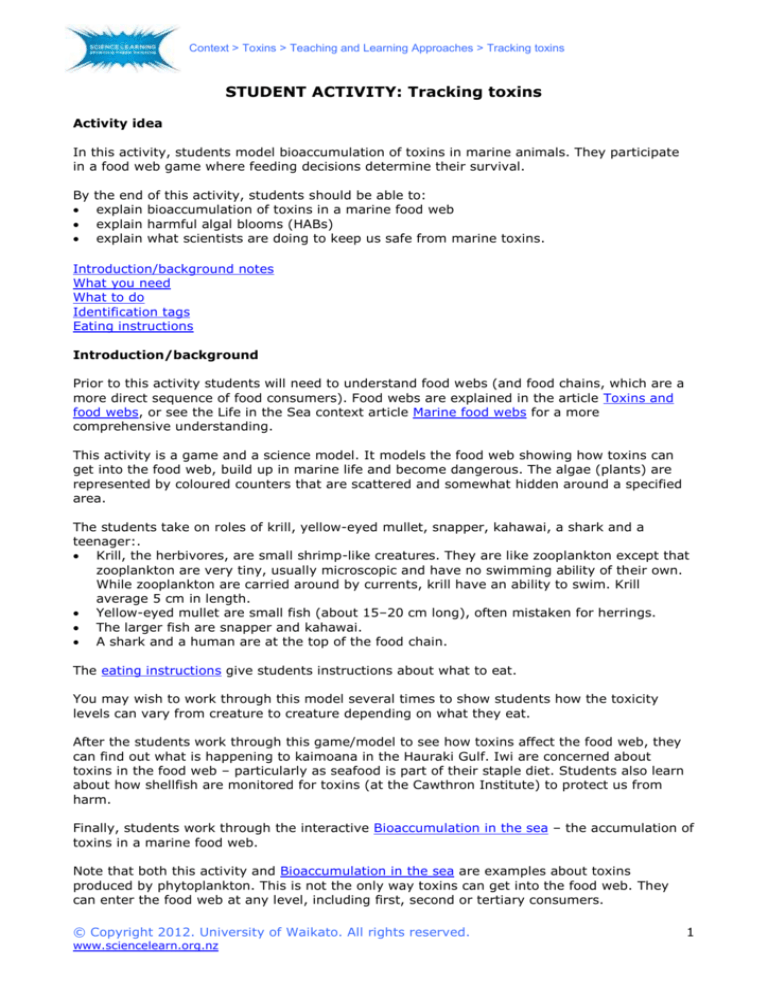
Context > Toxins > Teaching and Learning Approaches > Tracking toxins
STUDENT ACTIVITY: Tracking toxins
Activity idea
In this activity, students model bioaccumulation of toxins in marine animals. They participate
in a food web game where feeding decisions determine their survival.
By
the end
explain
explain
explain
of this activity, students should be able to:
bioaccumulation of toxins in a marine food web
harmful algal blooms (HABs)
what scientists are doing to keep us safe from marine toxins.
Introduction/background notes
What you need
What to do
Identification tags
Eating instructions
Introduction/background
Prior to this activity students will need to understand food webs (and food chains, which are a
more direct sequence of food consumers). Food webs are explained in the article Toxins and
food webs, or see the Life in the Sea context article Marine food webs for a more
comprehensive understanding.
This activity is a game and a science model. It models the food web showing how toxins can
get into the food web, build up in marine life and become dangerous. The algae (plants) are
represented by coloured counters that are scattered and somewhat hidden around a specified
area.
The students take on roles of krill, yellow-eyed mullet, snapper, kahawai, a shark and a
teenager:.
Krill, the herbivores, are small shrimp-like creatures. They are like zooplankton except that
zooplankton are very tiny, usually microscopic and have no swimming ability of their own.
While zooplankton are carried around by currents, krill have an ability to swim. Krill
average 5 cm in length.
Yellow-eyed mullet are small fish (about 15–20 cm long), often mistaken for herrings.
The larger fish are snapper and kahawai.
A shark and a human are at the top of the food chain.
The eating instructions give students instructions about what to eat.
You may wish to work through this model several times to show students how the toxicity
levels can vary from creature to creature depending on what they eat.
After the students work through this game/model to see how toxins affect the food web, they
can find out what is happening to kaimoana in the Hauraki Gulf. Iwi are concerned about
toxins in the food web – particularly as seafood is part of their staple diet. Students also learn
about how shellfish are monitored for toxins (at the Cawthron Institute) to protect us from
harm.
Finally, students work through the interactive Bioaccumulation in the sea – the accumulation of
toxins in a marine food web.
Note that both this activity and Bioaccumulation in the sea are examples about toxins
produced by phytoplankton. This is not the only way toxins can get into the food web. They
can enter the food web at any level, including first, second or tertiary consumers.
© Copyright 2012. University of Waikato. All rights reserved.
www.sciencelearn.org.nz
1
Context > Toxins > Teaching and Learning Approaches > Tracking toxins
What you need
Copies of the articles Toxins and food webs, Kaimoana in the Hauraki Gulf, Monitoring
shellfish
Access to the video clips Testing for toxins in kaimoana and Collaboration
Access to the interactive Bioaccumulation in the sea
A set of identification tags and small safety pins
About 15 small plastic bags (one for each krill)
100 coloured counters – 30 of them should be red
A set of eating instructions
Some cones for designating an area for the sea
What to do
Before the activity
1. Mark out an area that is to be the sea. Use cones or something similar to define the area –
big enough for the class to move about in.
2. Randomly distribute 100 coloured counters throughout the area (do this before beginning
the lesson so students don’t see where you put them). These are algae. Make sure there
are 30 (30%) red ones. These are toxic algae but don’t tell the students that.
The activity
3. As a class, read and discuss Toxins and food webs.
4. Divide the class into feeding levels or trophic groups as follows:
1 teenager (omnivore/tertiary consumer/eats plants and animals)
1 shark (carnivore/tertiary consumer/eats other carnivores)
4 large fish – 2 snapper/2 kahawai (carnivores/tertiary consumers/eat other carnivores)
7–8 small fish – yellow-eyed mullet (primary and secondary consumers/eat plants and
herbivores)
15+ krill (herbivores/primary consumers). If you have fewer students, reduce the
number of krill eaten by the mullet.
5. Cut out and distribute the identification tags (or have students write their role on a name
label). Students need to wear the tag or label identifying their role in this food web activity.
6. Gather the class to an area just outside the ‘sea’. Give out small plastic ‘food’ bags to each
krill. Tell students they will be given eating instructions shortly, and they need to follow the
instructions on them carefully. Don’t give the cards out yet.
7. Tell the students there has been an algal bloom. It is the herbivores (krill) that eat the
algae. Give the eating instructions to the krill and give them a limited time to enter the sea
area, find and ‘eat’ their algae (30–60 seconds depending on the number of students/size
of the area). The krill put their ‘food’ (counters) into their plastic bags. When time is up,
give a stop/freeze command. The krill can stay in the area – but not get any more food just
yet.
8. From now on, the secondary consumers are feeding. Whenever any consumer is ‘eaten’,
they must give up their food bag and sit down. Give the eating instructions to the yelloweyed mullet. On your command, they read their card, enter the area and follow the
instructions. Krill that are ‘eaten’ must relinquish their food bags and sit down. As the
mullet begin to follow their instructions, remaining krill may continue to graze on any
remaining algae.
© Copyright 2012. University of Waikato. All rights reserved.
www.sciencelearn.org.nz
2
Context > Toxins > Teaching and Learning Approaches > Tracking toxins
9. Give the larger fish (snapper and kahawai) their eating instructions and, on command, read
their card, enter and accomplish what they are instructed to do.
10. Have the shark read and action their eating instructions.
11. The teenager then goes fishing at the edge of the sea area. They catch a large fish
according to their instructions.
12. Once the human has cooked and eaten their fish, have the class gather together in a
group. Have students share what was on their cards so everyone knows what took place.
13. Tell the students that some of the algae were toxic and that the toxin has moved through
the food web. If the students have red counters, they have consumed toxic algae!
Have the students with food bags go through their food bags and count the total
number of counters they have collected, then count the number of red counters.
Calculate the amount of toxic algae as a percentage of their total consumption
[100 x red counters]÷[total counters]
If any krill are alive that ate any toxic algae (they have red counters in their food bags),
they are now dead.
If there any yellow-eyed mullet still alive that ate more than 20% of the toxic algae
(red counters), they are now dead.
If there are any larger fish (snapper or kahawai) still alive that ate between 20–30% of
the toxic algae (red counters), they are now sick. If there are larger fish that ate over
30% of the toxic algae (red counters), they are now dead.
If the shark consumed between 20–30% of the toxic algae (red counters), it is now
sick. If it ate more than 30% of the toxic algae (red counters), it is now dead.
If the teenager ate more than 20% of the toxic algae (red counters), they are sick. If
they ate more than 30% of the toxic algae (red counters), they should go to hospital
because they are very sick.
14. As a class or in groups, discuss what happened during this activity. Students should be
aware of how toxins from algae can build up through the food web and that these natural
toxins can be the cause of sickness and death to marine life. Humans also need to be
cautious when there are harmful algal blooms because the toxins produced at this level can
easily get into seafood we might eat.
After the activity
15. Read Kaimoana in the Hauraki Gulf to see why Māori are concerned about marine toxins.
Also read Monitoring shellfish to see how shellfish are monitored for toxins so that we are
kept safe.
16. Watch the video clips Testing for toxins in kaimoana and Collaboration.
17. In pairs, work through the interactive Bioaccumulation in the sea.
© Copyright 2012. University of Waikato. All rights reserved.
www.sciencelearn.org.nz
3
Context > Toxins > Teaching and Learning Approaches > Tracking toxins
Identification tags
© Copyright 2012. University of Waikato. All rights reserved.
www.sciencelearn.org.nz
1
Context > Toxins > Teaching and Learning Approaches > Tracking toxins
© Copyright 2012. University of Waikato. All rights reserved.
www.sciencelearn.org.nz
2
Context > Toxins > Teaching and Learning Approaches > Tracking toxins
© Copyright 2012. University of Waikato. All rights reserved.
www.sciencelearn.org.nz
3
Context > Toxins > Teaching and Learning Approaches > Tracking toxins
© Copyright 2012. University of Waikato. All rights reserved.
www.sciencelearn.org.nz
4
Context > Toxins > Teaching and Learning Approaches > Tracking toxins
Eating instructions
© Copyright 2012. University of Waikato. All rights reserved.
www.sciencelearn.org.nz
5
Context > Toxins > Teaching and Learning Approaches > Tracking toxins
© Copyright 2012. University of Waikato. All rights reserved.
www.sciencelearn.org.nz
6
Context > Toxins > Teaching and Learning Approaches > Tracking toxins
© Copyright 2012. University of Waikato. All rights reserved.
www.sciencelearn.org.nz
7
Context > Toxins > Teaching and Learning Approaches > Tracking toxins
© Copyright 2012. University of Waikato. All rights reserved.
www.sciencelearn.org.nz
8


